
Nationalpark Hunsrück-Hochwald: Where Wilderness Returns
Discover Germany's Hunsrück-Hochwald National Park: Witness the return of wilderness, explore ancient forests, and immerse yourself in nature's tranquility in this ecological haven.
The Nationalpark Hunsrück-Hochwald, established in 2015, is a sprawling natural haven where visitors can witness the resurgence of untouched wilderness. Located in the heart of the Hunsrück region, this park offers a diverse landscape of ancient beech forests, mysterious moorlands, and rocky slopes. It's a place where rare animal and plant species thrive, and where the motto is 'Let nature be nature.' Explore well-marked hiking trails, discover remnants of Celtic settlements, and immerse yourself in the tranquility of this unique ecosystem. Whether you're an avid hiker, a nature enthusiast, or simply seeking a peaceful escape, the Nationalpark Hunsrück-Hochwald promises an unforgettable experience. The park's commitment to accessibility ensures that people of all abilities can enjoy its wonders, with trails and information available in multiple formats.
A brief summary to Nationalparkamt Hunsrück-Hochwald
- Brückener Str. 24, Birkenfeld, 55765, DE
- +4961318841520
- Visit website
Local tips
- Download the Nationalpark Hunsrück-Hochwald app for offline maps and information, especially useful as network coverage can be spotty in the park's interior.
- Check the park's website for ranger-led tours; they offer invaluable insights into the park's ecology and history.
- Wear sturdy hiking shoes and dress in layers, as the weather in the Hunsrück can change quickly.
- Visit the Celtic ring wall in Otzenhausen to experience the region's rich cultural heritage.
- Pack a picnic to enjoy amidst the park's serene landscapes, but remember to leave no trace behind.
Getting There
-
Public Transport
From Birkenfeld, the Nationalparkamt Hunsrück-Hochwald is easily accessible by local bus services. Several bus lines connect Birkenfeld Marktplatz to stops near the park's entrance or visitor centers. Check the RNN (Rhein-Nahe Nahverkehrsverbund) website or app for the most up-to-date schedules and routes. A single bus fare within the Birkenfeld region typically costs around €3-5. From the bus stop, follow the signs to the Nationalparkamt, approximately a 5-10 minute walk.
-
Walking
If starting from accommodations in Birkenfeld, walking to the Nationalparkamt is feasible. From the town center, head north on Brückener Straße. The walk is approximately 1.5 kilometers and should take around 20-30 minutes. The route is well-marked and offers pleasant views of the surrounding area.
-
Taxi/Ride-Share
Taxis and ride-sharing services are available in Birkenfeld. A short taxi ride from the Birkenfeld train station or town center to the Nationalparkamt will cost approximately €10-15. Ensure the driver knows the destination, as there are multiple entrances to the National Park.
-
Driving
If driving, navigate to Brückener Straße 24, 55765 Birkenfeld. Limited parking is available directly at the Nationalparkamt. Parking is free. Alternatively, park in Birkenfeld and walk to the office.
Discover more about Nationalparkamt Hunsrück-Hochwald
Iconic landmarks you can’t miss
Nationalparkamt Hunsrück-Hochwald
0.0 km
Discover Germany's Hunsrück-Hochwald National Park: Witness the return of wilderness, explore ancient forests, and immerse yourself in nature's tranquility in this ecological haven.

Hunsrück-Hochwald National Park
8.0 km
Discover Germany's newest national park: a haven of ancient beech forests, rare moorlands, and Celtic history, where nature reclaims its space and offers unforgettable adventures.
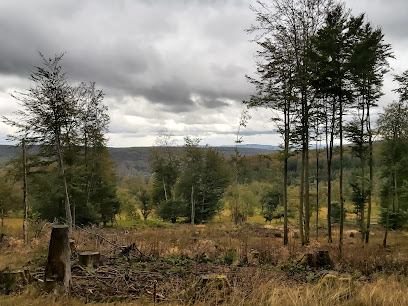
Traumschleife Rund um die Kama
12.8 km
Discover the enchanting Traumschleife Rund um die Kama near Idar-Oberstein: a blend of scenic hiking, gemstone history, and Roman heritage in the heart of the Saar-Hunsrück.
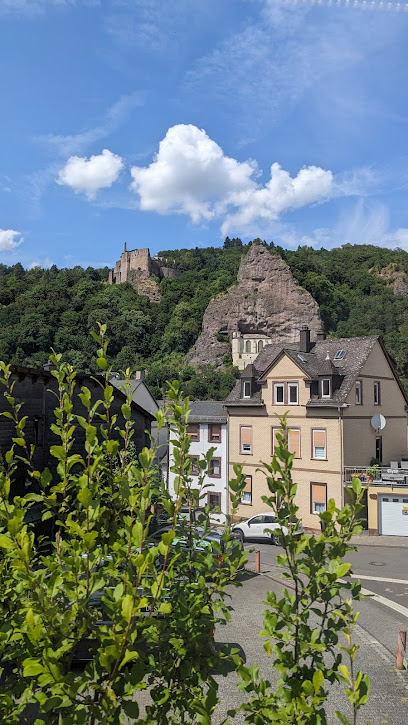
Kempfeld - Schönster Ort im Hunsrück
17.1 km
Discover Kempfeld, the 'Most Beautiful Place in Hunsrück': Explore scenic landscapes, delve into rich history, and experience German hospitality in this charming village.
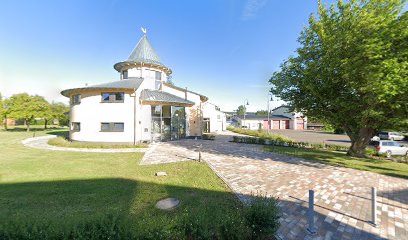
Hankelbrunnen
19.8 km
Discover the enchanting Hankelbrunnen in Herrstein, a historic fountain surrounded by lush greenery and charming half-timbered houses, embodying the town's unique cultural heritage.
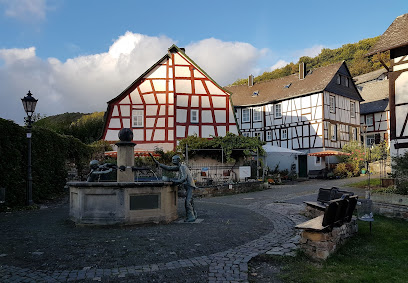
Schillereiche auf dem Wartekopf
21.7 km
Experience the breathtaking natural beauty and tranquil atmosphere at Schillereiche auf dem Wartekopf in Ulmet, Germany, a perfect destination for nature lovers.
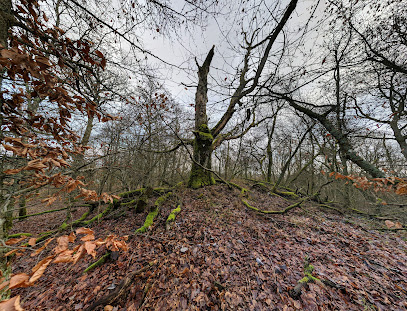
Wandern im Hunsrück
27.4 km
Discover the Hunsrück's diverse hiking trails: explore rolling hills, dense forests, and historical landmarks in this picturesque German region between the Rhine and Moselle.
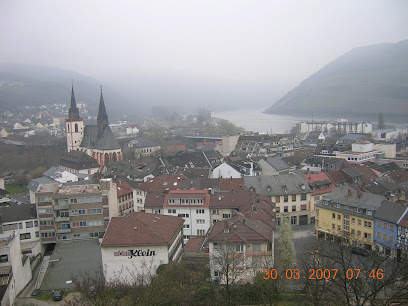
Anti-tank trench WWII
28.8 km
Discover the historic Anti-tank Trench in Ottweiler, a remarkable WWII landmark steeped in history and resilience, perfect for history enthusiasts and curious travelers.
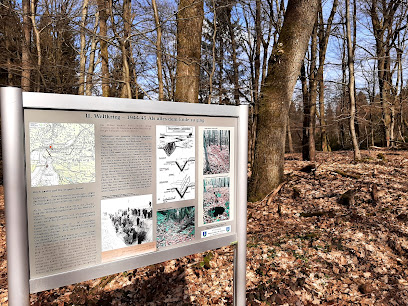
Mosellandtouristik GmbH
30.3 km
Discover the charm of the Mosel region with Mosellandtouristik, your go-to travel agency for unforgettable experiences and local insights.
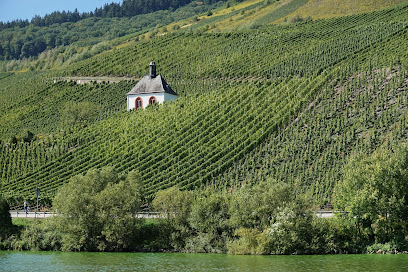
Schloss Lieser
31.5 km
Experience the grandeur of a bygone era at Schloss Lieser, a meticulously restored castle hotel in the heart of the Moselle Valley, surrounded by vineyards and steeped in history.

Saar-Hunsrück-Steig
33.1 km
Discover Germany's Saar-Hunsrück-Steig: A 410km hiking paradise through forests, valleys, and historical sites, awarded as the country's most beautiful long-distance trail.
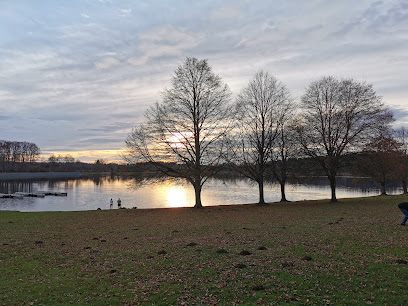
Hahn Airport
33.8 km
Discover Hahn Airport, a key international hub in Lautzenhausen, Germany, offering modern facilities and seamless travel connections to Europe and beyond.
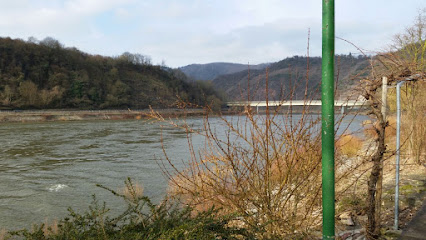
Hunsrück-Touristik GmbH
33.8 km
Discover the beauty and culture of the Hunsrück region with expert guidance at Hunsrück-Touristik GmbH, your essential tourist information center.
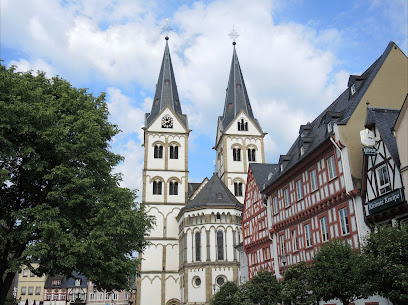
Hunsrücker Oktoberfest
34.5 km
Experience the heart of Bavaria at Hunsrücker Oktoberfest, where traditional music, food, and festivities create an unforgettable atmosphere.
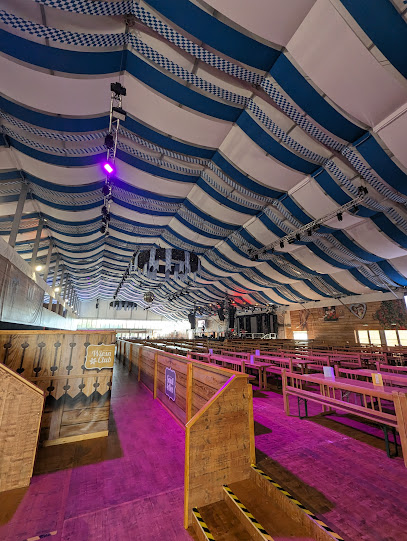
Wallmauer Bastion Pfalzel
36.0 km
Explore the Wallmauer Bastion Pfalzel in Trier, a historic gem showcasing medieval architecture and stunning views of the Moselle Valley.
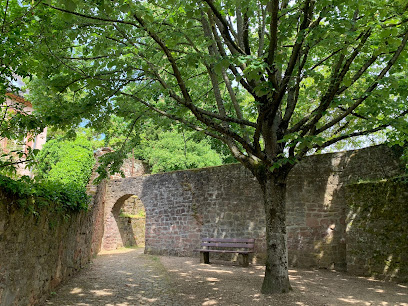
Unmissable attractions to see
Hinkelstein, Walhausen
11.1 km
Explore the Hinkelstein in Walhausen - a historic megalith that blends folklore with breathtaking natural beauty in Nohfelden, Germany.
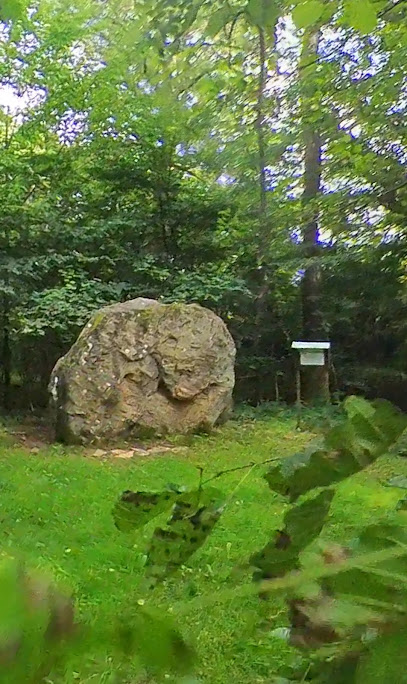
Burg Dagstuhl
22.6 km
Explore the historical marvel of Burg Dagstuhl, a captivating castle in Wadern, steeped in medieval charm and surrounded by breathtaking scenery.
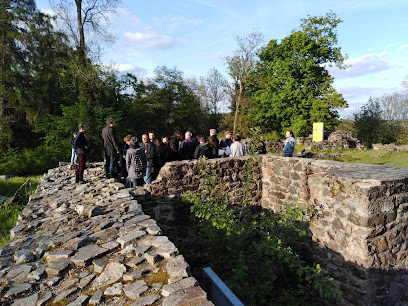
Schloss Veldenz
27.5 km
Discover the enchanting Schloss Veldenz, a historical landmark and hiking area in Germany that offers breathtaking views and rich cultural heritage.
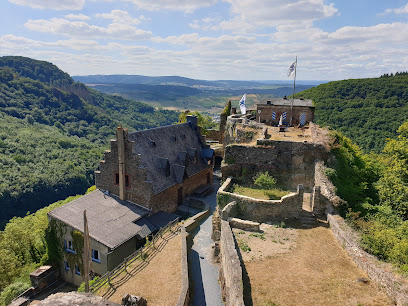
Weinhaus Kurtrierer Hof GbR
27.6 km
Experience the exquisite wines and delightful cuisine at Weinhaus Kurtrierer Hof, the perfect retreat in the heart of the Moselle region.
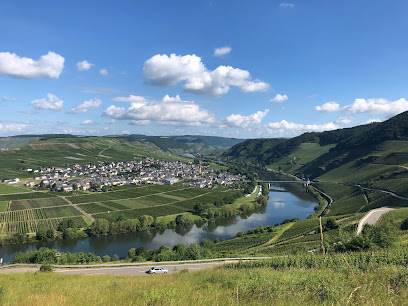
Nahe-Skywalk
29.8 km
Experience breathtaking panoramic views of the Nahe Valley at the stunning Nahe-Skywalk in Hochstetten-Dhaun, a must-visit observation deck.
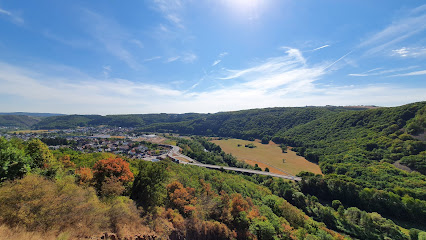
Burg Landshut
29.9 km
Explore the enchanting Burg Landshut in Bernkastel-Kues, a captivating historical landmark with breathtaking views and delightful European cuisine.
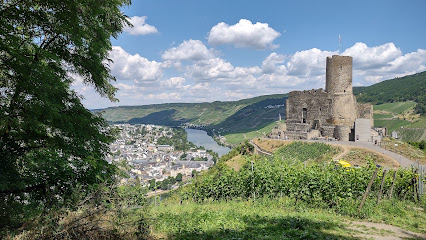
Advent Calendar House
30.3 km
Discover the enchanting charm of the Advent Calendar House in Bernkastel-Kues, where holiday magic comes alive all year round.
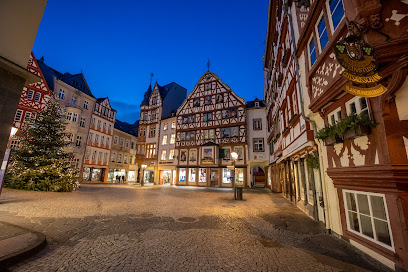
Cusanus -Sonnenuhr
30.4 km
Explore the enchanting Cusanus - Sonnenuhr in Bernkastel-Kues, where art meets astronomy in a stunning sundial experience.
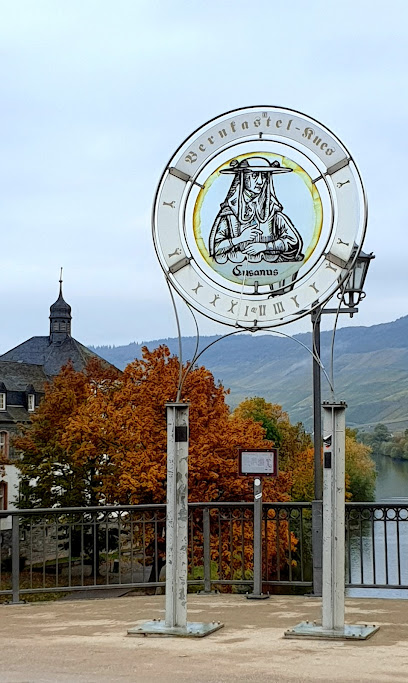
Museum Graacher Tor
30.5 km
Explore the cultural heritage of Bernkastel-Kues at Museum Graacher Tor, a captivating heritage museum filled with stories and artifacts.
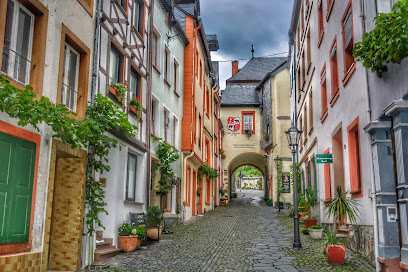
Mosel-Weinmuseum und Moselvinothek
30.5 km
Discover the rich heritage of Mosel wines at the Mosel-Weinmuseum und Moselvinothek in Bernkastel-Kues – a must-visit for tourists and wine lovers alike.
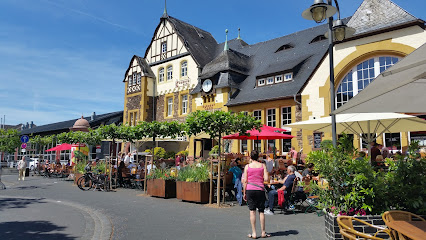
Wildstein
30.9 km
Discover the serene hiking trails and breathtaking landscapes of Wildstein in Traben-Trarbach, a perfect getaway for nature lovers and outdoor adventurers.
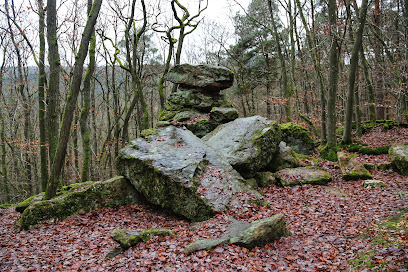
Panoramablick
31.4 km
Discover breathtaking views of the Moselle River at Panoramablick, an enchanting observation deck in Piesport, Germany, perfect for nature lovers and photographers.
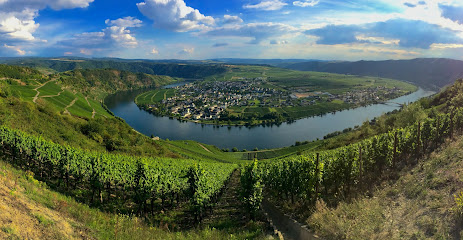
Moselle Hills
32.8 km
Explore the breathtaking Moselle Hills, a stunning mountain peak near Klüsserath, perfect for hiking, wine tasting, and immersing in local culture.
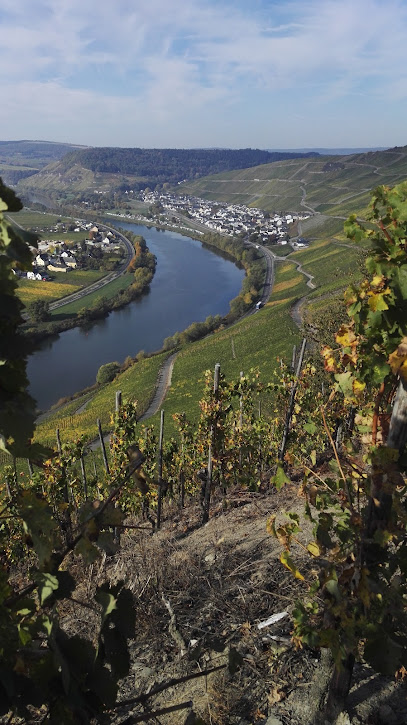
Old Wolfstein Castle
32.9 km
Explore Old Wolfstein Castle: A Historical Gem Offering Scenic Views and Hiking Adventures in the Heart of Germany.
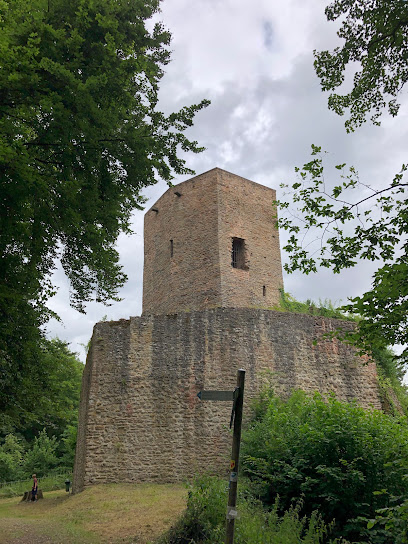
Römische Villa urbana
32.9 km
Explore the Römische Villa Urbana, a stunning Roman villa reconstruction in Longuich, Germany, showcasing ancient architecture and history.
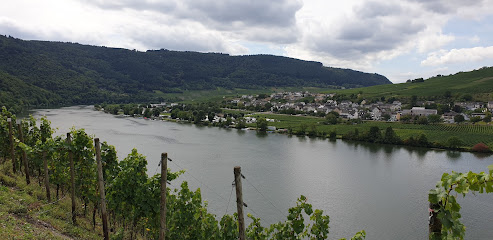
Essential places to dine
Landgasthof Alt-Birkenfeld
1.3 km
Discover the essence of traditional German dining at Landgasthof Alt-Birkenfeld in beautiful Birkenfeld.
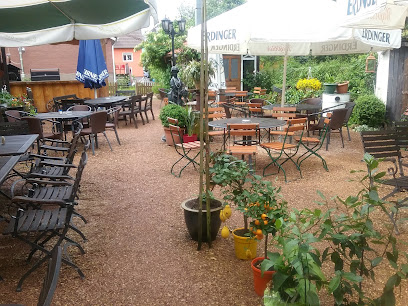
Das Spießbratenhaus - Restaurant Alte-Kanzlei
14.1 km
Experience authentic German flavors at Das Spießbratenhaus in Idar-Oberstein, where traditional meat dishes meet a cozy atmosphere.
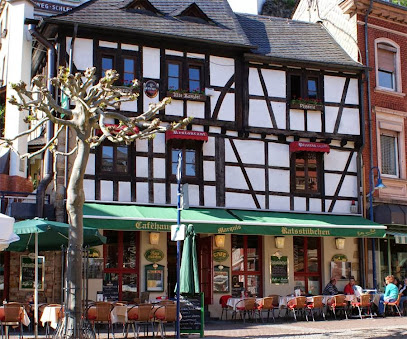
Landgasthof Schuck
19.2 km
Discover cozy accommodations and authentic German cuisine at Landgasthof Schuck in picturesque Kirchenbollenbach.
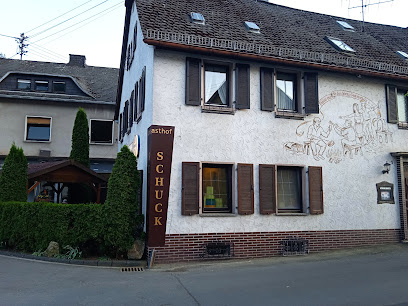
Waldgaststätte Hubehaus
20.4 km
Discover the essence of traditional German dining at Waldgaststätte Hubehaus in Kusel, where rustic charm meets delectable cuisine.
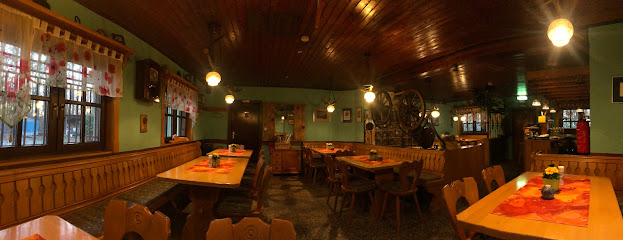
Wein & Tafelhaus
26.4 km
Discover exquisite fine dining at Wein & Tafelhaus in Trittenheim - where local flavors meet elegant ambiance along the Mosel River.
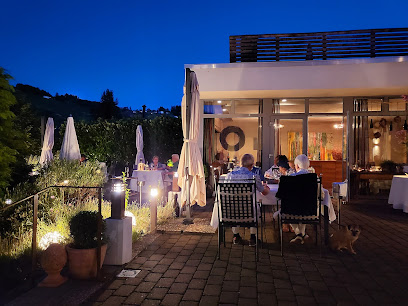
Restaurant Kyrburg
26.5 km
Discover exquisite dining at Restaurant Kyrburg in Kirn - where local flavors meet stunning views in a charming atmosphere.
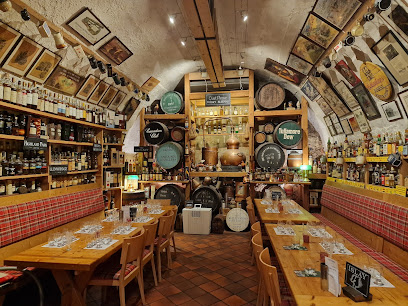
Moselhotel Ludwigs
29.6 km
Experience exceptional hospitality and authentic local cuisine at Moselhotel Ludwigs in the scenic Mosel Valley.

Brühler Hof Inh. Fam. Eckert
30.0 km
Experience authentic German cuisine at Brühler Hof in Wintrich—where tradition meets exceptional dining.
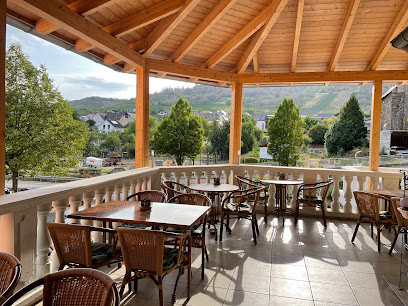
Restaurant Alt Bernkastel
30.1 km
Discover authentic flavors at Restaurant Alt Bernkastel, where local cuisine meets warm hospitality in the heart of Bernkastel-Kues.

Restaurant Ochs
30.2 km
Experience authentic European flavors at Restaurant Ochs in Bernkastel-Kues, where delicious meat dishes meet charming ambiance.
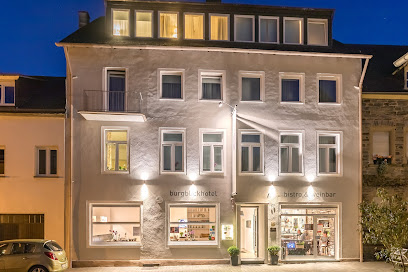
Restaurant Anno 1640
30.3 km
Experience authentic German cuisine at Restaurant Anno 1640 in Bernkastel-Kues, where tradition meets modern culinary excellence.
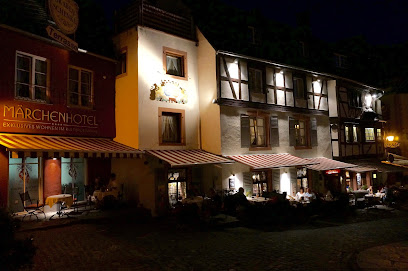
schanz. restaurant.
30.4 km
Experience exquisite fine dining at Schanz Restaurant in Piesport – where culinary artistry meets local flavors amidst stunning vineyard views.
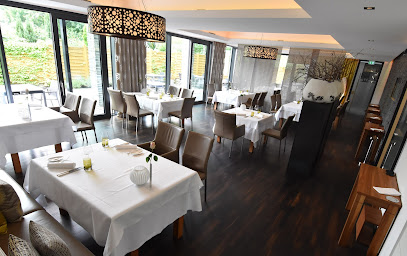
Restaurant Cafe Thiesen
30.4 km
Experience exquisite dining at Restaurant Cafe Thiesen in Bernkastel-Kues - where local flavors meet modern culinary artistry.
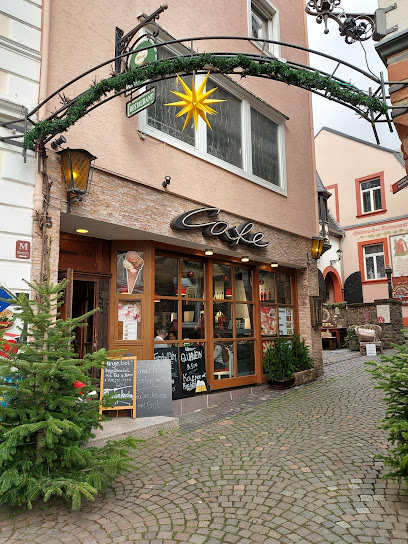
Restaurant Graacher Tor
30.4 km
Experience authentic Moselle cuisine at Restaurant Graacher Tor in Bernkastel-Kues – where every meal tells a story.
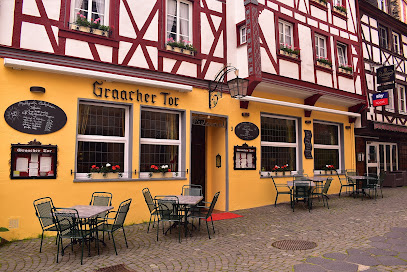
Alter Moselbahnhof
30.5 km
Experience exquisite dining at Alter Moselbahnhof with stunning views over the Mosel River in Bernkastel-Kues.
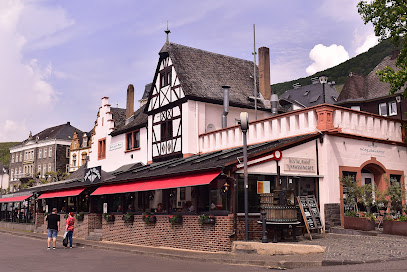
Markets, malls and hidden boutiques
RukaDesign
27.1 km
Discover unique gifts and local craftsmanship at RukaDesign in Eppelborn, a must-visit destination for tourists seeking memorable souvenirs.

MaKa Creativ
30.4 km
Uncover unique gifts and personalized picture framing services at MaKa Creativ, a must-visit shop for creative souvenirs.

Karlsbader Platz
30.4 km
Experience the enchanting Karlsbader Platz in Bernkastel-Kues, a vibrant plaza offering local culture, charm, and scenic views.
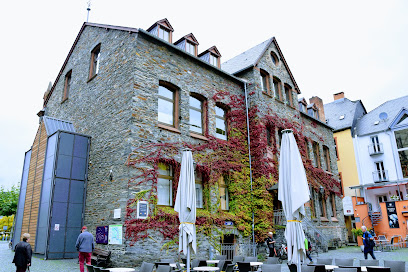
Erika Thiel Textilhandel
30.9 km
Explore the vibrant world of textiles at Erika Thiel Textilhandel in Illingen, a fabric lover's paradise with a diverse selection for all your crafting needs.
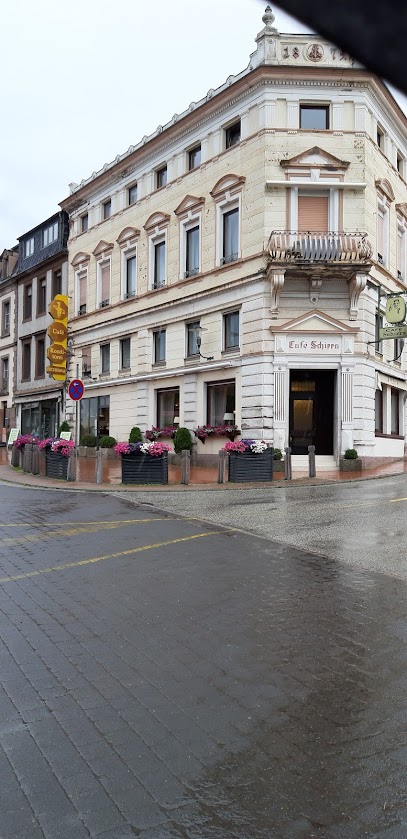
Alex Jeans
30.9 km
Discover high-quality denim and stylish men's clothing at Alex Jeans, the go-to fashion spot in Illingen, Germany.

Inside Mode Für Sie
30.9 km
Discover style and elegance at Inside Mode Für Sie, a boutique in Illingen offering curated fashion and personalized service.

Mystery Auktionshaus
31.0 km
Explore cutting-edge gadgets and rare collectibles at Mystery Auktionshaus, a must-visit electronics store in Illingen, Germany.

Boutique Monique
31.2 km
Discover Boutique Monique in Illingen: A unique shopping destination for fashion lovers with curated styles and personalized service.

Die Vitrine
31.4 km
Experience the essence of Brauneberg at Die Vitrine, where handcrafted gifts meet exquisite local wines in a charming setting.
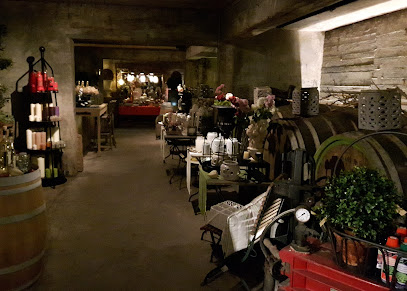
Mode Studio S
32.3 km
Explore the vibrant fashion scene at Mode Studio S, Illingen's premier clothing store offering unique styles and personalized service for every fashion lover.
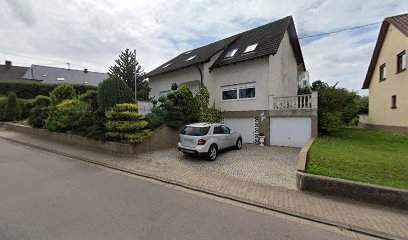
Top Designer Brands Wholesale Stock Apparel
32.6 km
Explore Top Designer Brands Wholesale Stock Apparel in Sohren for unbeatable prices on stylish clothing and accessories for the whole family.

Diversio GmbH & Co. KG
32.7 km
Discover top-notch workwear and outdoor gear at Diversio GmbH & Co. KG in Sohren, your destination for quality and variety.

Sports&More Ulli Weckmann e.K.
32.8 km
Explore Lautzenhausen with top-notch gear from Sports&More Ulli Weckmann, your premier sporting goods destination for all outdoor adventures.
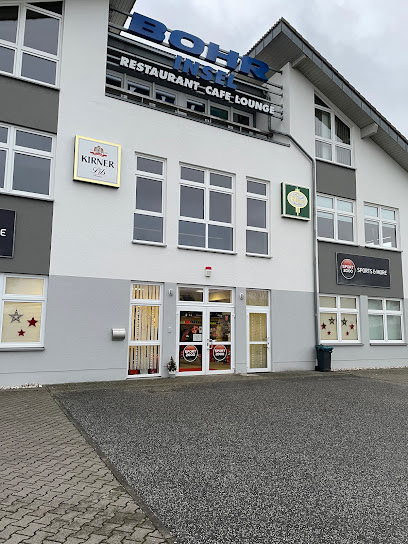
KommA - Fachgeschäft für Papier und mehr
32.9 km
Discover unique gifts and local treasures at KommA in Merchweiler, the perfect stop for tourists seeking memorable souvenirs.

Creation Gross
33.1 km
Explore Creation Gross in Illingen for unique handcrafted souvenirs that celebrate the essence of German culture and craftsmanship.

Essential bars & hidden hideouts
VW Cocktail‘s GbR
11.6 km
Discover the vibrant cocktail culture at VW Cocktail‘s GbR in Idar-Oberstein, where unique flavors and a lively atmosphere await every visitor.
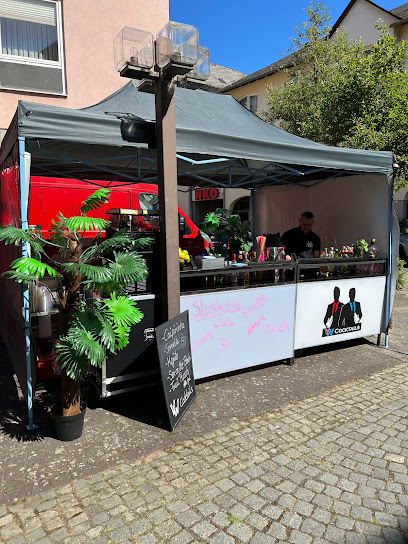
EX-IT Cocktail-/Shisha-Bar
26.9 km
Experience the vibrant nightlife at EX-IT Cocktail-/Shisha-Bar in Kirn, where exceptional cocktails and shisha await in a chic atmosphere.

Weinstube St. Sebastian
30.2 km
Experience authentic Mosel cuisine and exceptional wines at Weinstube St. Sebastian in charming Bernkastel-Kues.
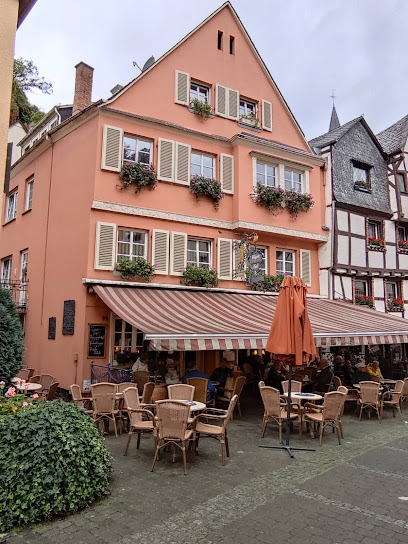
Weinstube Spitzhäuschen
30.3 km
Experience the essence of Mosel wines at Weinstube Spitzhäuschen, a charming wine bar in Bernkastel-Kues offering local flavors and warm hospitality.
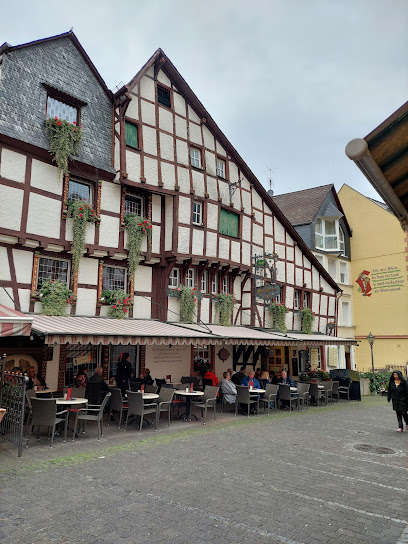
Bitchen
30.3 km
Discover the cozy charm of Bitchen, a vibrant pub in Bernkastel-Kues offering local brews, hearty meals, and a warm atmosphere.
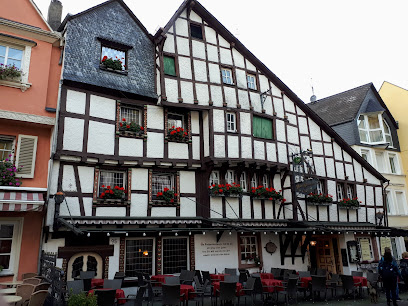
Brückenkeller
30.4 km
Explore the exquisite wines of Bernkastel-Kues at Brückenkeller, a cozy wine bar offering local and international selections in an inviting atmosphere.
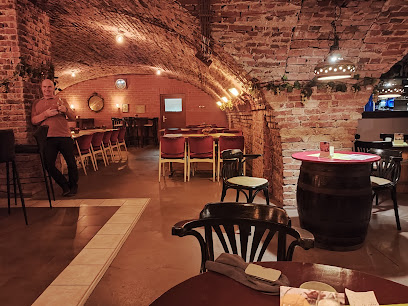
Wunderbar Cocktailbar
30.4 km
Experience the lively atmosphere and expertly crafted cocktails at Wunderbar Cocktailbar in Bernkastel-Kues.
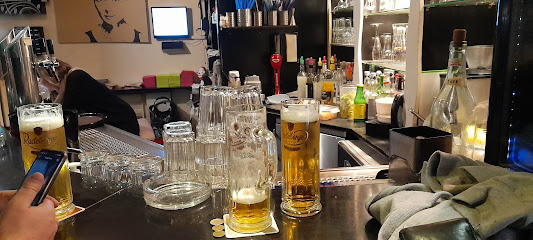
Tresor Wine & Bar
30.5 km
Experience the charm of Bernkastel-Kues at Tresor Wine & Bar, where exquisite wines and a cozy atmosphere await every visitor.

Hotel Weisser Bär
31.4 km
Immerse yourself in the culinary wonders of Hotel Weisser Bär, where local flavors meet exceptional hospitality in the scenic Moselle region.

Stella Biergarten & Scheunenrestaurant
32.3 km
Discover traditional German flavors in a cozy atmosphere at Stella Biergarten & Scheunenrestaurant, a must-visit dining destination in Simmertal.
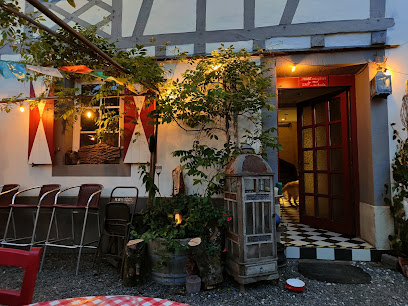
Chillout
33.1 km
Experience the best of Neunkirchen's nightlife at Chillout, your go-to bar for relaxation and socializing with friends.
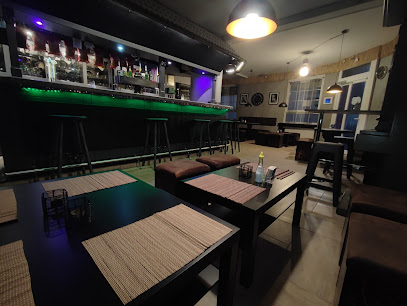
La Roca's Brew Pub
33.2 km
Experience the vibrant atmosphere and local brews at La Roca's Brew Pub in Merchweiler, a top choice for beer lovers and social butterflies.
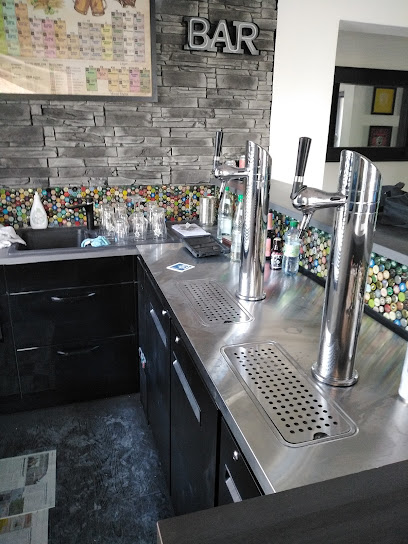
Saloon Luckie Luke
33.4 km
Discover the vibrant local scene at Saloon Luckie Luke, a unique bar and café in Lautzenhausen offering local brews and delightful snacks.
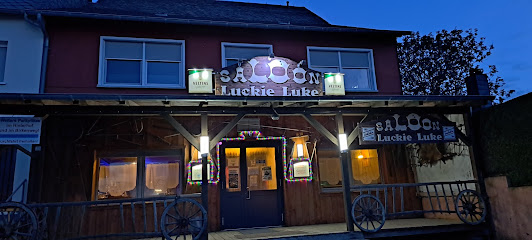
MyPlace - hotel.bar.restaurant
33.5 km
Experience the perfect blend of comfort, dining, and nightlife at MyPlace - your ultimate destination in Lautzenhausen.

Cocos Café & Sportsbar Traben Trarbach
33.6 km
Experience the vibrant atmosphere of Cocos Café & Sportsbar in Traben-Trarbach, where delicious food meets exhilarating sports entertainment.




